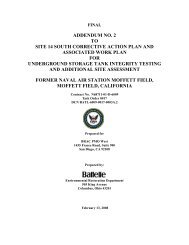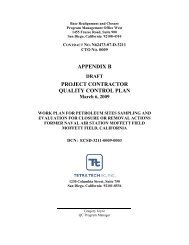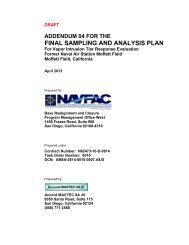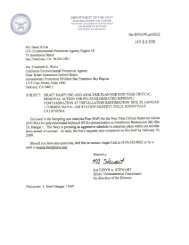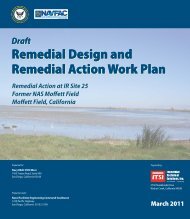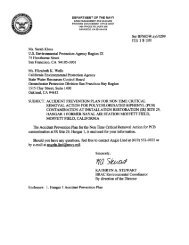- Page 1 and 2:
Draft Remedial Design and Remedial
- Page 3 and 4:
Draft RD/RAWP Remedial Action at IR
- Page 5 and 6:
Draft RD/RAWP Remedial Action at IR
- Page 7 and 8:
Draft RD/RAWP Remedial Action at IR
- Page 10 and 11:
Draft RD/RAWP Remedial Action at IR
- Page 12 and 13:
Draft RD/RAWP Remedial Action at IR
- Page 14 and 15:
Draft RD/RAWP Remedial Action at IR
- Page 16 and 17:
Draft RD/RAWP Remedial Action at IR
- Page 18 and 19:
Draft RD/RAWP Remedial Action at IR
- Page 20 and 21:
Draft RD/RAWP Remedial Action at IR
- Page 22 and 23:
Draft RD/RAWP Remedial Action at IR
- Page 24 and 25:
Draft RD/RAWP Remedial Action at IR
- Page 26 and 27:
Draft RD/RAWP Remedial Action at IR
- Page 28 and 29:
• A permit t from NASAA ARC will
- Page 30 and 31:
Draft RD/RAWP Remedial Action at IR
- Page 32 and 33:
Draft RD/RAWP Remedial Action at IR
- Page 34 and 35:
Draft RD/RAWP Remedial Action at IR
- Page 36 and 37:
Draft RD/RAWP Remedial Action at IR
- Page 38 and 39:
Draft RD/RAWP Remedial Action at IR
- Page 40 and 41:
Draft RD/RAWP Remedial Action at IR
- Page 42 and 43:
Draft RD/RAWP Remedial Action at IR
- Page 44 and 45:
Draft RD/RAWP Remedial Action at IR
- Page 46 and 47:
Draft RD/RAWP Remedial Action at IR
- Page 48 and 49:
Table 1 - Site-Specific Remediation
- Page 50:
Table 2 - Key Personnel (continued)
- Page 55:
NAVY Contracting Officer Charles De
- Page 59 and 60:
Draft Quality Control Plan Remedial
- Page 61 and 62:
ACRONYMS AND ABBREVIATIONS AB AHA A
- Page 63 and 64:
Draft Quality Control Plan Remedial
- Page 65 and 66:
Draft Quality Control Plan Remedial
- Page 67 and 68:
• O Organizing and maintaining al
- Page 69 and 70:
Draft Quality Control Plan Remedial
- Page 71 and 72:
Draft Quality Control Plan Remedial
- Page 73 and 74:
Draft Quality Control Plan Remedial
- Page 75 and 76:
Draft Quality Control Plan Remedial
- Page 77 and 78:
Draft Quality Control Plan Remedial
- Page 79 and 80:
Draft Quality Control Plan Remedial
- Page 81 and 82:
Draft Quality Control Plan Remedial
- Page 83:
QCP ATTACHMENT 1 DESIGNATION LETTER
- Page 89 and 90:
AND LOCATION T R A N S M I T T A L
- Page 109 and 110:
Project-Specific SAP for the Remedi
- Page 111 and 112:
Project-Specific SAP for the Remedi
- Page 113 and 114:
Project-Specific SAP for the Remedi
- Page 115 and 116:
Project-Specific SAP for the Remedi
- Page 117 and 118:
Project-Specific SAP for the Remedi
- Page 119 and 120:
Project-Specific SAP for the Remedi
- Page 121 and 122:
Project-Specific SAP for the Remedi
- Page 123 and 124:
Project-Specific SAP for the Remedi
- Page 125 and 126:
Project-Specific SAP for the Remedi
- Page 127 and 128:
Project-Specific SAP for the Remedi
- Page 129 and 130:
Project-Specific SAP for the Remedi
- Page 131 and 132:
Project-Specific SAP for the Remedi
- Page 133 and 134:
Project-Specific SAP for the Remedi
- Page 135 and 136:
Project-Specific SAP for the Remedi
- Page 137 and 138:
Project-Specific SAP for the Remedi
- Page 139 and 140:
Project-Specific SAP for the Remedi
- Page 141 and 142:
Project-Specific SAP for the Remedi
- Page 143 and 144:
Project-Specific SAP for the Remedi
- Page 145 and 146:
Project-Specific SAP for the Remedi
- Page 147 and 148:
Project-Specific SAP for the Remedi
- Page 149 and 150:
Project-Specific SAP for the Remedi
- Page 151 and 152:
Project-Specific SAP for the Remedi
- Page 153 and 154:
Project-Specific SAP for the Remedi
- Page 155 and 156:
Project-Specific SAP for the Remedi
- Page 157 and 158:
Project-Specific SAP for the Remedi
- Page 159 and 160:
Project-Specific SAP for the Remedi
- Page 161 and 162:
Project-Specific SAP for the Remedi
- Page 163 and 164:
Project-Specific SAP for the Remedi
- Page 165 and 166:
Project-Specific SAP for the Remedi
- Page 167 and 168:
Project-Specific SAP for the Remedi
- Page 169 and 170:
Project-Specific SAP for the Remedi
- Page 171 and 172:
Project-Specific SAP for the Remedi
- Page 173 and 174:
Project-Specific SAP for the Remedi
- Page 175 and 176:
Project-Specific SAP for the Remedi
- Page 177 and 178:
Project-Specific SAP for the Remedi
- Page 179 and 180:
Project-Specific SAP for the Remedi
- Page 181 and 182:
Project-Specific SAP for the Remedi
- Page 183:
References California Department of
- Page 200 and 201:
SAP ATTACHMENT 1 SAMPLE FIELD FORMS
- Page 202 and 203:
2730 Shadelands Drive, Suite 100 Wa
- Page 204:
Sheet ____ of ____ Low-Flow Groundw
- Page 207 and 208:
2730 Shadelands Drive, Suite 100 Wa
- Page 209 and 210:
SAP ATTACHMENT 2 SAMPLE QUALITY CON
- Page 211 and 212:
Sheet _____ of _____ NON ROUTINE OC
- Page 213 and 214:
Standard Operating Procedure Shallo
- Page 215 and 216:
Standard Operating Procedure Shallo
- Page 217 and 218:
Standard Operating Procedure Shallo
- Page 219 and 220:
Standard Operating Procedure Shallo
- Page 221 and 222:
Standard Operating Procedure Sample
- Page 223 and 224:
Standard Operating Procedure Sample
- Page 225 and 226:
Standard Operating Procedure Sample
- Page 227 and 228:
Standard Operating Procedure Sample
- Page 229 and 230:
Attachment A Sample Preservation an
- Page 231 and 232:
Attachment A Sample Preservation an
- Page 233 and 234:
Standard Operating Procedure Field
- Page 235 and 236:
Standard Operating Procedure Field
- Page 237 and 238:
Standard Operating Procedure Field
- Page 239 and 240:
Standard Operating Procedure Field
- Page 241 and 242:
Standard Operating Procedure Field
- Page 243 and 244:
Standard Operating Procedure Field
- Page 245 and 246:
Standard Operating Procedure Field
- Page 247 and 248:
Standard Operating Procedure Sample
- Page 249 and 250:
Standard Operating Procedure Field
- Page 251 and 252:
Standard Operating Procedure Field
- Page 253 and 254:
Standard Operating Procedure Field
- Page 255 and 256:
Standard Operating Procedure Field
- Page 257 and 258:
Standard Operating Procedure Field
- Page 259 and 260:
Standard Operating Procedure Sample
- Page 261 and 262:
Standard Operating Procedure Sample
- Page 263 and 264: Standard Operating Procedure Sample
- Page 265 and 266: Standard Operating Procedure Sample
- Page 267 and 268: Standard Operating Procedure Sample
- Page 269 and 270: Event Location ID Sample Type Field
- Page 275 and 276: SAP ATTACHMENT 5 RWQCB Screening fo
- Page 277 and 278: Table B. Environmental Screening Le
- Page 279 and 280: Table B. Environmental Screening Le
- Page 283: ID Task Name Duration Start Finish
- Page 304 and 305: TABLE OF CONTENTS TABLE OF CONTENTS
- Page 306 and 307: EXECUTIVE SUMMARY This Biological A
- Page 308 and 309: Figure 1. Project Action Area with
- Page 310 and 311: sampling. The qualified biologist w
- Page 312 and 313: experienced botanist will inspect a
- Page 316 and 317: Habitat Photo 1. Pickleweed/Saltgra
- Page 318 and 319: Habitatt Photo 4. Eastern Diked Mar
- Page 320 and 321: Page 18 of 57
- Page 322 and 323: Table 1 Continued Scientific Name C
- Page 324 and 325: Table 2. Federally‐listed Fish fr
- Page 326 and 327: Table 3. Federally‐listed Birds f
- Page 328 and 329: Table 4. Federally‐listed Mammals
- Page 330 and 331: icarioides missionensis). Appropria
- Page 332 and 333: Table 6. Special‐status Plants fr
- Page 334 and 335: Figure 10. Critical habitats design
- Page 336 and 337: No federally-listed invertebrate sp
- Page 338 and 339: Acronyms and Abbreviations CDFG CEQ
- Page 340 and 341: References Barbour M.G., T. Keeler-
- Page 342 and 343: USFWS. 2010a. U.S. Fish and Wildlif
- Page 344 and 345: Page 42 of 57
- Page 346 and 347: Page 44 of 57
- Page 348 and 349: Appendix D. Species List for Milpit
- Page 350 and 351: Page 48 of 57
- Page 352 and 353: Page 50 of 57
- Page 354 and 355: Page 52 of 57
- Page 356 and 357: Scientific Name Common Name Family
- Page 358 and 359: Scientific Name Common Name Family
- Page 361 and 362: Table 1. Special‐status Amphibian
- Page 363 and 364: Table 2. Special‐status Fish from
- Page 365 and 366:
Table 3. Special‐status Birds fro
- Page 367 and 368:
Table 3. Continued. Scientific Name
- Page 369 and 370:
Table 4. Special‐status Mammals f
- Page 371 and 372:
Table 5. Special‐status Invertebr
- Page 373 and 374:
Table 6. Special‐status Plants fr
- Page 375 and 376:
Table 6. Continued Scientific Name
- Page 377 and 378:
Table 6. Continued Scientific Name
- Page 379:
Table 6. Continued Scientific Name



